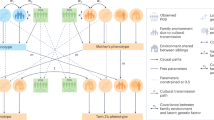Abstract
Odds ratios derived from probandwise concordance rates are usually interpreted as increased risks in twins. Though the odds ratios in case–control studies have been shown to reflect rate ratios, few studies focused on such relationships in twin studies. The authors derived an approximate formula for the ratios of person-time incidence rates after the random assignment of twins into index twins and co-twins, i.e., incidence rate ratios. The resulting rate ratio was estimated as the product of the concordance odds ratio and a term that reflect the follow-up duration and the average time to occurrence of disease. Odds ratios coincide with rate ratios when the average time to occurrence of disease is half the duration of follow-up, although in studies spanning several decades these two measures might be different. The authors illustrated that when the incidence rate is not constant over the follow-up period as in longitudinal twin studies, the conventional odds ratio should not be used as an estimator of rate ratio.
Similar content being viewed by others
References
Smith C. Concordance in twins: Methods and interpretation. Am J Hum Genet 1974; 26: 454–466.
Kraemer HC. What is the ‘right’ statistical measure of twin concordance (or diagnostic reliability and validity)? Arch Gen Psychiatry 1997; 54: 1121–1124.
McGue M. When assessing twin concordance, use the probandwise not the pairwise rate. Schizophr Bull 1992; 18: 171–176.
Allen G, Harvald B, Shields J. Measures of twin concordance. Acta Genet Stat Med 1967; 17: 475–481.
Kendler KS, Neale MC, Kessler RC, Heath AC, Eaves LJ. A longitudinal twin study of 1-year prevalence of major depression in women. Arch Gen Psychiatry 1993; 50: 843–852.
Kendler KS, Prescott CA. A population-based twin study of lifetime major depression in men and women. Arch Gen Psychiatry 1999; 56: 39–44.
Ramarkrishan V, Goldberg J, Henderson WG, et al. Elementary methods for the analysis of dichotomous outcomes in unselected samples of twins. Genet Epidemiol 1992; 9: 272–287.
Cornfield J. A method of estimating comparative rates from clinical data. Applications to cancer of the lung, breast, and cervix. J Natl Cancer Inst 1951; 11: 1269–1275.
Gao XJ, Klar N, Donner A. Comparison of methods for analyzing binary data arising from two-sample twin studies. Genet Epidemiol 1997; 14: 349–363.
Heagerty PJ, Zeger SL. Marginal regression models for clustered ordinal measurements. J Am Stat Assoc 1996; 91: 1024–1036.
Betensky RA, Hudson JI, Jones CA, et al. A computationally simple test of homogeneity of odds ratios for twin data. Genet Epidemiol 2001; 20(2): 228–238.
Hudson JI, Laird NM, Betensky RA, Keck PE Jr., Pope HG Jr., Multivariate logistic regression for familial aggregation of two disorders. II. Analysis of studies of eating and mood disorders. Am J Epidemiol 2001; 153: 506–514.
Kumar D, Gemayel NS, Deapen D, et al. North-American twins with IDDM. Genetic, etiological, and clinical significance of disease concordance according to age, zygosity, and the interval after diagnosis in first twin. Diabetes 1993; 42: 1351–1363.
Agresti A. Categorical Data Analysis. 2nd ed. Hoboken, New Jersey: John Wiley Sons, 2002.
Verkasalo PK, Kaprio J, Koskenvuo M, Pukkala E. Genetic predisposition, environment and cancer incidence: A nationwide twin study in Finland, 1976-1995. Int J Cancer 1999; 83: 743–749.
Posner SF, Pedersen NL, Gatz M. Application of life table analysis to the onset of dementia in a genetically informative design. Am J Med Genet 1999; 88: 207–210.
Kumar D, Gemayel NS, Gill SK, et al. Type-specific concordance in young diabetic monozygotic twins. Adv Exp Med Biol 1988; 246: 259–267.
Kyvik KO, Green A, Beck-Nielsen H. Concordance rates of insulin dependent diabetes mellitus: A population based study of young Danish twins. Br Med J 1995; 311: 913–917.
Lipsitz SR, Laird NM, Harrington DP. Generalized estimating equations for correlated binary data: Using the odds ratio as a measure of association. Biometrika 1991; 78: 153–160.
Lichtenstein P, Holm NV, Verkasalo PK, et al. Environmental and heritable factors in the causation of cancer. N Engl J Med 2000; 343: 78–85.
Author information
Authors and Affiliations
Rights and permissions
About this article
Cite this article
Lee, MS., Lee, SI., Yun, S. et al. Concordance odds ratios and approximate rate ratios in longitudinal twin studies. Eur J Epidemiol 18, 1047–1050 (2003). https://doi.org/10.1023/A:1026135902307
Issue Date:
DOI: https://doi.org/10.1023/A:1026135902307




